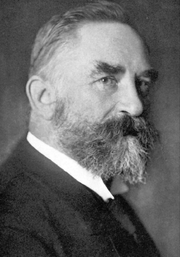
Constantin von Monakow
Encyclopedia


Vologda Oblast
Vologda Oblast is a federal subject of Russia . Its administrative center is Vologda. The largest city is Cherepovets.Vologda Oblast is rich in historic monuments, such as the magnificent Kirillo-Belozersky Monastery, Ferapontov Convent , medieval towns of Velikiy Ustyug and Belozersk, baroque...
.
He studied at the University of Zurich
University of Zurich
The University of Zurich , located in the city of Zurich, is the largest university in Switzerland, with over 25,000 students. It was founded in 1833 from the existing colleges of theology, law, medicine and a new faculty of philosophy....
while working as an assistant at the Burghölzli
Burghölzli
Burghölzli is the common name given for the psychiatric hospital of the University of Zürich, Switzerland. The hospital is located on "Burghölzli", a wooded hill in the district of Riesbach of southeastern Zürich....
Institute under the directorship of Eduard Hitzig
Eduard Hitzig
Eduard Hitzig was a German neurologist and neuropsychiatrist born in Berlin.He studied medicine at the Universities of Berlin and Würzburg, and had as instructors, famous men such as Emil Du Bois-Reymond , Rudolf Virchow , Moritz Heinrich Romberg and Karl Friedrich Otto Westphal...
(1839-1907). After graduation, he was an assistant at St. Pirminsberg, where he performed scientific investigations of cerebral anatomy
Anatomy
Anatomy is a branch of biology and medicine that is the consideration of the structure of living things. It is a general term that includes human anatomy, animal anatomy , and plant anatomy...
. In 1885 he returned to Zurich
Zürich
Zurich is the largest city in Switzerland and the capital of the canton of Zurich. It is located in central Switzerland at the northwestern tip of Lake Zurich...
, where he later became director of the Brain Anatomy Institute. In 1917 he founded the Swiss Archives of Neurology and Psychiatry, and was its editor-in-chief until his death in 1930.
Monakow made numerous contributions in his analysis involving the sensory
Sensory cortex
The sensory cortex can refer informally to the primary somatosensory cortex, or it can be used as an umbrella term for the primary and secondary cortices of the different senses : the visual cortex on the occipital lobes, the auditory cortex on the temporal lobes, the primary olfactory cortex on...
and motor
Motor cortex
Motor cortex is a term that describes regions of the cerebral cortex involved in the planning, control, and execution of voluntary motor functions.-Anatomy of the motor cortex :The motor cortex can be divided into four main parts:...
pathways of the brain. He was interested in the functional relationships amongst the different regions of the brain, and conceptualized that in faculties such as intellect, coordination was needed among its many diverse parts. From his brain research he introduced the terms "chronogenic localization" and "diaschisis
Diaschisis
Diaschisis is a sudden loss of function in a portion of the brain connected to but at a distance of a damaged area. The site of the originally damaged area and of the diaschisis are connected to each other by neurons. The loss of the damaged structure disrupts the function of the remaining intact...
".
In 1914 Monakow coined the term diaschisis to describe how an injury to the brain can create behavioral deficiencies which may be followed by eventual recovery. The word is derived from Greek, meaning "shocked throughout". He believed the brain to exist as a delicate balance between its different components, and if a component became disturbed through injury it could affect other parts of the brain not seemingly associated with the site of injury. Therefore, if the damage wasn't too severe, functional behaviour would recover once the period of diaschisis wore off.
He name is lent to "Monakow's nucleus" (lateral cuneate nucleus
Cuneate nucleus
One of the dorsal column nuclei, the cuneate nucleus is a wedge-shaped nucleus in the closed part of the medulla oblongata. It contains cells that give rise to the cuneate tubercle, visible on the posterior aspect of the medulla...
) and to the "bundle of Monakow" (rubrospinal fasciculus). In addition "Monakow's syndrome" is named after him, which is defined as contralateral hemiplegia
Hemiplegia
Hemiplegia /he.mə.pliː.dʒiə/ is total paralysis of the arm, leg, and trunk on the same side of the body. Hemiplegia is more severe than hemiparesis, wherein one half of the body has less marked weakness....
, hemianaesthesia and homonomous hemianopsia due to occlusion of the anterior choroidal artery
Anterior choroidal artery
The anterior choroidal artery originates from the internal carotid artery, though it also rarely arises from the middle cerebral artery.-Structures supplied:The anterior choroidal artery serves many structures in the cerebrum:...
.
He was responsible for identifying the arcuate fasciculus
Arcuate fasciculus
The arcuate fasciculus is the neural pathway connecting the posterior part of the temporoparietal junction with the frontal cortex in the brain and is now considered as part of the superior longitudinal fasciculus..-Neuroanatomy:...
as the fibre tract that connected the Broca's
Broca's area
Broca's area is a region of the hominid brain with functions linked to speech production.The production of language has been linked to the Broca’s area since Pierre Paul Broca reported impairments in two patients. They had lost the ability to speak after injury to the posterior inferior frontal...
and Wernicke's
Wernicke's area
Wernicke's area is one of the two parts of the cerebral cortex linked since the late nineteenth century to speech . It is involved in the understanding of written and spoken language...
speech areas. This anatomical link (which is now questioned) “soon became a dogma in neurology and still today provides the backbone of anatomical models of language.”
Selected writings
- Pathologie du cerveau, in German as Gehirnpathologie (1897)
- Über Lokalisation der Hirnfunktion (1910)
- La localisation de l'encephale et la dégradation fonctionelle par des lésions circonscrites du cortex cérébral, in German as Die Lokalisation im Grosshirn und Abbau der Funktion durch kortikale Herde (1914)
- Gefuhl, Gesittung und Gehirn, (1916)
- Psychiatrie und Biologie, (1919)
- Schizophrenie und Plexus chorioidei (with Kitabayashi), 1919

